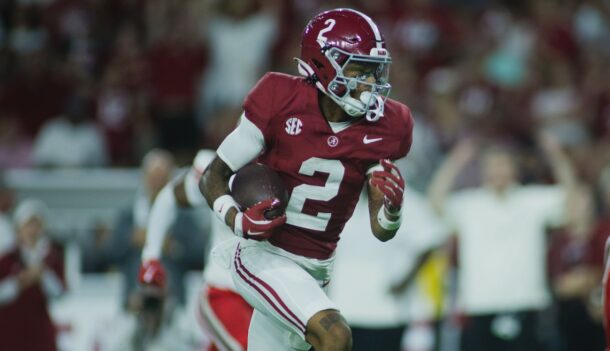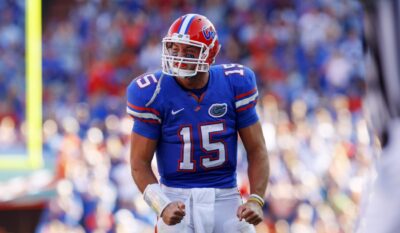
College football didn’t have to reach this point — but here we are
By Alex Hickey
Published:
None of this ever had to be inevitable. But when our institutions are led by those who are guided by the bottom line and have zero consideration for any mitigating factors, this is what we get.
A world where college football isn’t benefitting its emotional stakeholders, the actual fans. Or the majority of its participant institutions.
For the most part, the only excitement for the Big Ten’s poaching of UCLA and USC is coming from the 16 schools that will benefit from the largesse. There was also a great deal of cheerleading from Big Ten Network, which took a turn into territory associated with North Korean state TV as it unabashedly celebrated Thursday’s news.
Some Ohio State and Michigan fans seem excited by the addition of another marquee football program. But other than that, the reception feels muted. Few are celebrating the move, though many are defending it as necessary.
“Well, the SEC added Texas and Oklahoma last year! The Big Ten had to respond!”
Unfortunately, that’s the attitude of escalation that sent us down this destabilizing path in the first place. At any point, an actual leader might have recognized where this was heading and found a collaborative solution.
Instead, we’re moving in a direction where a depressingly small number of college programs will actually matter.
The snowball that never stopped rolling
The first time a USC football player finds himself shivering at SHI Stadium, he can thank Texas and ESPN for putting him in Piscataway. The Longhorn Network placed everyone in this mess a decade ago.
At the time, perhaps the Big 12 could have stopped the snowball from forming.
Want your own network? Fine. Go be an independent. We’ll find a 12th member.
Instead, conference leaders caved to Texas’ demands. Nebraska said “the heck with that,” and decamped for the Big Ten. Texas A&M did the same with the SEC, bringing Missouri along for little more than balance. Colorado read the room and left it for the seeming security of the expanded Pac-12.
The moves were justifiable reactions to Texas trying to grab a bigger piece of the pie than any of its partners. But the fissure created by separating A&M from Texas and Mizzou from Kansas was a bad harbinger of things to come.
Protecting rivalries and tradition was no longer a priority — or even a consideration. That reality brought Rutgers and Maryland into the Big Ten for purely financial reasons in 2014. Then-commissioner Jim Delany knew the access to New York City and Washington, D.C., would add considerable value to the Big Ten Network and all of the league’s members.
But the addition of that value was a crucial moment in unraveling college sports as a regional-first entity. Two football conferences — the Big East and WAC — simply folded once all the cards were played. This was no longer about universities grouping with their nearest peer institutions, though the B1G still peddles that falsehood.
The primary consideration for conferences became who could get the most TVs turned on.
The skids were well-greased by the time Rutgers and Maryland got to the B1G, but there was still an opportunity for nationwide stability. The carousel stopped spinning for 7 whole years.
And then Texas needed more. Again. Everything’s bigger there, including the insatiable thirst for cash.
The Longhorn Network no longer getting the job done, Texas brought along Red River rival Oklahoma to the SEC.
The Big 12 raided the American — a conference formed from the ashes of the Big East — to remain relevant.
This, again, is where things could have stopped. Because the next move was the one liable to push college sports from sitting on the brink to well past it.
Big Ten commissioner Kevin Warren seemed cognizant of that when forming the much-ballyhooed Alliance with the ACC and Pac-12 in response. That it was better for college football to have a high number of schools with access to the highest level.
Something changed. The coming weeks will surely reveal what that was. Perhaps being part of the Alliance made USC and UCLA realize how much better the Big Ten has it. Or maybe we’ll learn whether Warren was lying to the public about the Alliance, or simply to Pac-12 commissioner George Kliavkoff.
But now that we’re here, there’s very little appeal to the places we’re about to go.
The super conferences are coming
Whether it takes a couple years or a whole decade, the end is nigh for the little guys in college sports. And even many of the mid-sized guys. That’s the biggest tragedy in this situation, because the little and middle guys are what differentiate college athletics from the rest of the American sporting landscape.
Nowhere else is there an equivalent to Appalachian State beating Michigan in football. Or Boise State getting an opportunity to face an Oklahoma in the postseason, much less winning. Or an entity the size of St. Peter’s reaching the quarterfinal round of a tournament. Where No. 1 Virginia could lose to Chaminade. Or UMBC, depending on the decade.
We’re getting away from that.
This is an arms race now, and the B1G and SEC dictate the terms. If they each want to expand to 20 teams, they will. If it’s 24 they’re after, then there will be 48 fortunate schools at the highest level of college football. Either way, it’s a dramatic downgrade from the current 65 Power 5 programs.
It’ll look much like baseball did a century ago. The American and National Leagues were rivals, surrounded by dozens of minor leagues. There were no farm systems then — the big leagues would scout and purchase the best players, much as worldwide soccer clubs do now. As we’ve already started to see, that’s clearly where the college transfer portal is heading.
With that many teams in each conference, there won’t be any need to schedule nonconference games in football. Maybe not even in basketball. And if there even is an NCAA Tournament, you can bet the St. Peter’s of the world will be excluded.
If you’ve loved and cared about college sports, this will be a depressing balkanization to witness. Emotional appeal will erode. At some point, rooting for your alma mater won’t feel too different from rooting for a hedge fund.
Fans don’t watch college football because it’s played at a higher caliber than the NFL. They watch because it’s more fun. And much of the fun is in the variety. Air Force has to play football in a different style in order to compete. So does Texas Tech. And so on.
There’s nothing like it in the pros. There can’t be.
Even on the worst teams, every player is a professional athlete. In college, even the best teams have guys who will be bankers and gym teachers. And sometimes that leaves those great teams prone to upsets.
The smaller and more homogenized college football gets, those qualities will be lost. And at that point, the sport risks becoming the Triple-A version of the NFL.
Passion is what drives college football. For many, that passion will drive away. All to make room for a bigger Brinks truck.
Plenty in the Big Ten and SEC will profit. But what will it cost?
Alex Hickey is an award-winning columnist for Saturday Down South and Saturday Tradition, our Big Ten site.







